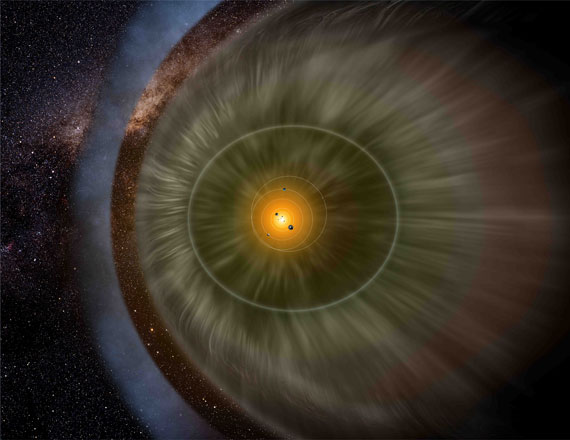*
Interstellar Boundary Exolorer (IBEX)
January 31, 2012
From Dave McComas, IBEX Principal Investigator:
Back in October 2009, we announced IBEX’s first major science results, including the observation of what has become known as the "IBEX Ribbon." Since that time, IBEX has been detecting energetic neutral atoms coming from the boundary of our Solar System and from regions of our Earth’s magnetosphere, and we have periodically updated the IBEX website with information on these topics.
In those first 2009 science results, we also announced the first–ever direct observations of neutral hydrogen and oxygen atoms drifting in from the interstellar medium, outside our heliosphere. Our talented science team has continued to make observations of these – and other – interstellar neutrals, and we are proud to showcase their work, published as a set of six papers in the February issue of Astrophysical Journal Supplements as a special section titled "IBEX Direct Observations of Interstellar Neutrals." I hope you will enjoy learning more about this fascinating aspect of IBEX’s exquisite capabilities, which are even allowing us to probe the local region outside our heliosphere. Congratulations to the members of the science team who worked hard on these amazing results – and GO IBEX!
What has IBEX detected?
IBEX has measured hydrogen, oxygen, neon, and helium atoms drifting in from outside our heliosphere toward Earth’s region of our Solar System. Atoms such as these are called "interstellar neutral atoms" or "ISNs." Prior to IBEX the only other spacecraft to detect ISNs was Ulysses, over a decade ago, and it could only measure neutral interstellar helium. IBEX’s measurements of interstellar hydrogen, oxygen, and neon are the first–ever detections of these atoms by any spacecraft. The IBEX–Lo instrument on IBEX detects all of these ISNs.
How do we know these ISNs are from outside our heliosphere?
Our Sun emits a "wind" of material outward, at an average of a million miles (1.6 million kilometers) per hour. As the solar wind streams away from the Sun, it races out toward the space between the stars. We think of this space as "empty" but it contains traces of gas, dust, and charged, or "ionized," gas – together called the "interstellar medium." The solar wind blows against this material and clears out a cavity–like region in the ionized gas. This cavity is called our "heliosphere."
Continued here...
**************************************************


No comments:
Post a Comment
LITS is a site dedicated to the study of the UFO and alien phenomena. You'll find information about UFO sightings, alien abductions, astronomy, science and technology.
This is a Non-profit site. Comments that contain URLs will be deleted.
I do not edit comments, so if you don't want your address posted and you have a question, or have had a sighting you wish to report, please email me directly, rather than post a comment. My email addresses are listed on the "Report UFO Sightings" page. Thank you.